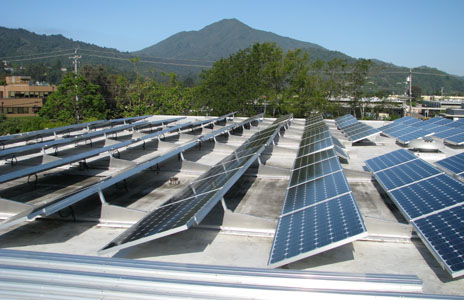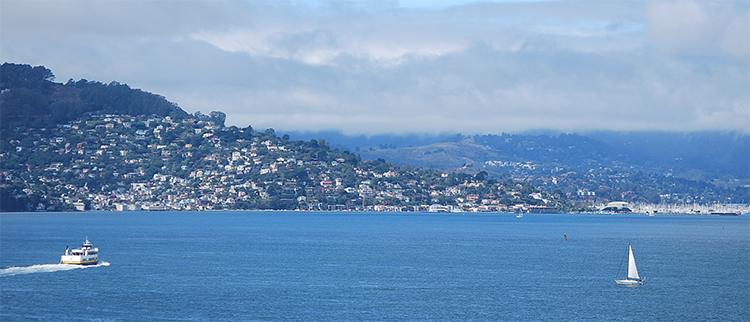The California city or town that purchased the highest percentage of its energy from renewable sources in the last six months was. . . Corte Madera. That’s right, the Marin County municipality outshone even greener-than-green San Francisco, earning Corte Madera a spot on the EPA’s national top 10 list of Green Power Communities.

Marin Clean Energy provides electricity to the Green Power Communities in Marin County. At least 50 percent of the electricity provided by MCE is derived by renewable sources, such as solar and wind. MCE was California’s first community choice aggregation program. As cities came online with the program, residents and businesses in those communities were automatically enrolled and had the option of opting out if they wished to remain PG&E customers. Photo courtesy of Marin Clean Energy
By Bill Picture
Published: June, 2013
The California city or town that purchased the highest percentage of its energy from renewable sources in the last six months was. . . Corte Madera. That’s right, the Marin County municipality outshone even greener-than-green San Francisco, earning Corte Madera a spot on the EPA’s national top 10 list of Green Power Communities. A Green Power Community is one whose energy users—government, commercial and residential—collectively exceed the green power purchase requirement set for that community by the EPA based on annual electricity usage.
Corte Madera Councilwoman Alexandra Cock says the news of her town’s top honors took her completely by surprise. "I had no idea until it was announced," she said, "but it’s really exciting because it wasn’t an easy thing to do."
Back in 2009, when the Corte Madera City Council was first presented with the opportunity to join the Marin Energy Authority (which administers the Marin Clean Energy program) and offer to Corte Madera businesses and households the chance to purchase largely renewably-sourced energy at a slightly higher rate than electricity from traditional sources, Cock was the only councilmember to cast a "yes" vote.
"We got another opportunity in 2011," she said. "And by then, the program was up and running. The other councilmembers saw that it was working, and that the cost was very similar." Enough of Cock’s colleagues were convinced by the proof in the pudding, and Corte Madera signed on. Still, one of the five councilmembers voted against joining the Marin Energy Authority. "People have different priorities," Cock said.
Judging from its inclusion in the EPA’s list, Corte Madera’s program has been a smashing success. Unlike many of its Bay Area neighbors, Corte Madera has yet to create a climate change action plan that would establish sustainability goals for the town to meet. San Francisco set such goals years ago, and has since put into motion comprehensive plans to meet or even exceed the established goals. For instance, San Francisco has begun installing solar panels on municipal properties to help power city facilities.
"But those things cost money, and we don’t have extra money for anything right now," Cock explained. "The last few years have been really hard. Things are improving, but the recovery is slow. And for now, we really have to pick and choose how we spend our money."
While Cock would like to see sustainability-minded projects on her town’s to-do list, for now she says the council remains focused on infrastructure needs, supporting development in town and beautification.
A big step in the right direction
While the switch to clean power is just a first step, it’s an important one, according to Mollie Lemon of the EPA’s Green Power Partnership. "For most municipalities, electricity usage is the single largest source of greenhouse gas emissions," she said. "By using green power, a community is reducing its carbon footprint, demonstrating civic leadership and improving public health. In some cases, green power may even be less expensive than traditional sources of electricity. Either way, choosing green power is one of the easiest and least disruptive changes a person or community can make that results in big benefits for everyone."
And though being recognized as a Green Power Community might not have the same effect as topping one of those annual "hippest cities in the country" lists, Lemon believes it’s a strong incentive for communities that aren’t yet on board with clean energy to do so pronto.
"By joining an elite group of communities that have been named Green Power Communities, 46 to date, a community can distinguish itself as a forward-thinking environmental leader," she said.
For those recognized as Green Power Communities, Lemon says the honor itself is just the tip of the iceberg, benefit-wise. "Being acknowledged as a Green Power Community demonstrates that a community is committed to improving the environment," she explained. "But the other benefits are reduced greenhouse gas emissions, enhanced community image and increased citizen pride."
And in a community such as Corte Madera, where it took two attempts to get local government to agree to push forward with clean power, the honor of being named a Green Power Community can help dispel any lasting fears or reservations. "It can increase stakeholders’ confidence in a green power purchase," Lemon said.
Corte Madera has many neighbors on the list. Larkspur, Fairfax, Mill Valley and San Anselmo joined Corte Madera in the national top 10. San Rafael, Ross, Tiburon and Belvedere made the top 15. That means 9 of Marin County’s 11 incorporated cities and towns make up 60 percent of the nation’s top 15 Green Power Communities.
The EPA began monitoring green power purchases in September 2012, and will continue to do so through the end of this September. When the results are finalized, one or more communities will be named "Green Power Community of the Year."
Could it be Corte Madera? Lemon wouldn’t be surprised. After all, she wasn’t surprised to see so many Bay Area communities at the top of the national list of Green Power Communities.
"California has long been seen as a leader in environmental innovation so it’s fitting," she said.
For more information on the EPA Green Power Communities, visit
www.epa.gov/greenpower/communities/index.htm

Nine of Marin County’s 11 incorporated cities and towns have been recognized by the EPA as Green Power Communities. All nine ranked in the top 15 communities in the country in terms of the percentage of clean energy purchased. Photo by Joel Williams

Though topping the list of California Green Power Communities, Corte Madera has yet to join fellow Marin County GPCs such as San Anselmo in drafting its own climate change action plan. For now, Corte Madera’s focus remains on maintaining the city’s infrastructure, supporting development and beautification efforts. Photo by Karen Schneider Photography

